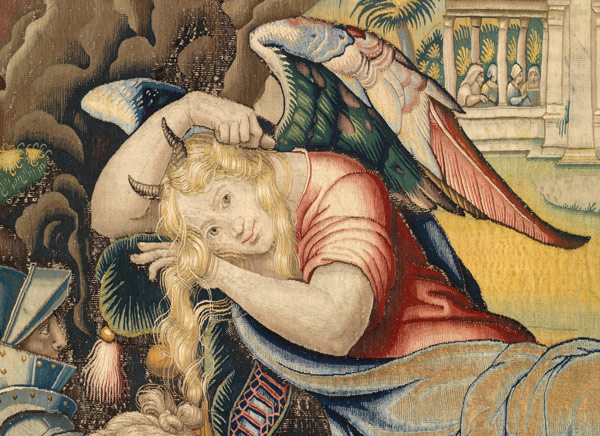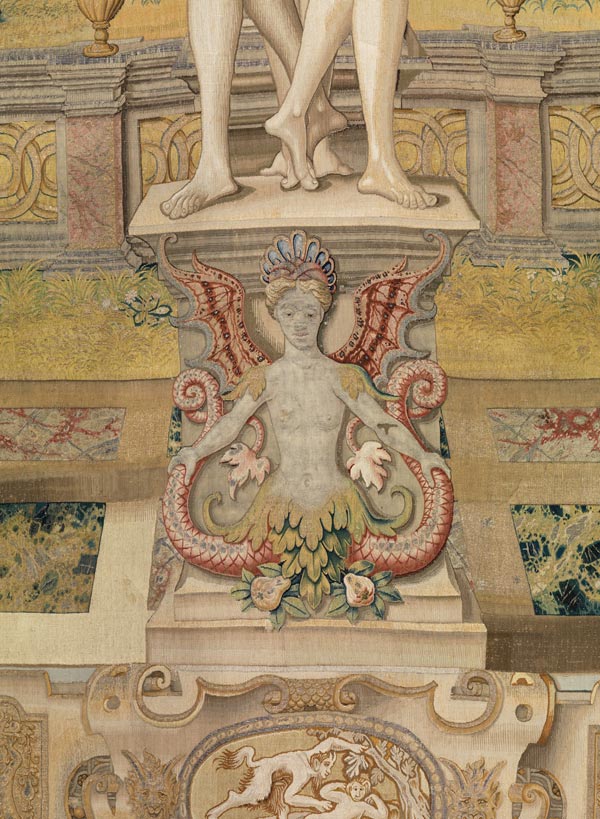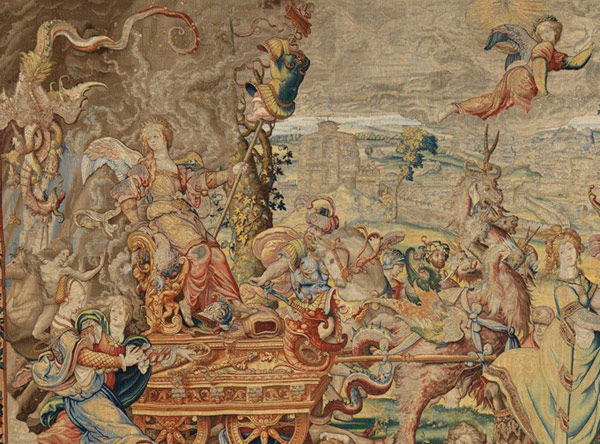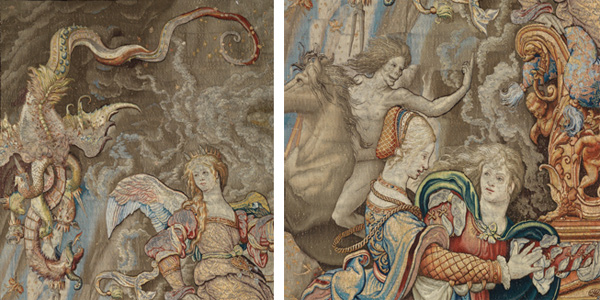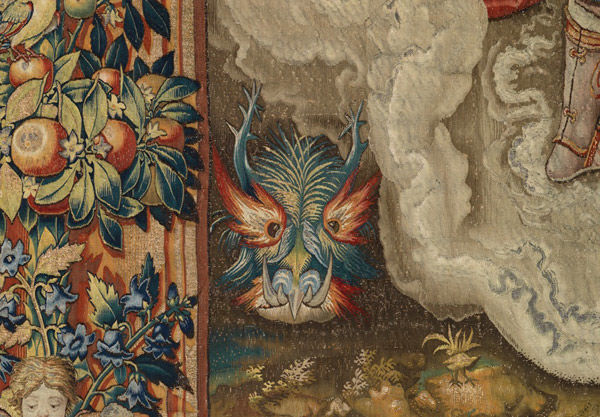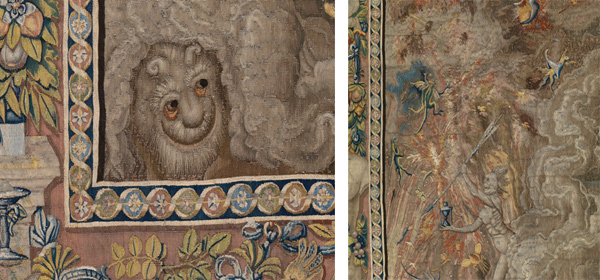Detail of Sloth personified from the Sloth tapestry in a set of the Seven Deadly Sins. Designed by Pieter Coecke van Aelst, ca. 1532–34. Woven under the direction of Willem de Pannemaker, Brussels, ca. 1548–49. Wool, silk, and silver- and silver-gilt-metal-wrapped threads. Kunsthistorisches Museum, Vienna (KK T XXXV/ 5). Photograph by Bruce White
Still need an idea for a Halloween costume? Look no further. All manner of magical, menacing, and mysterious monster lurks throughout the massive tapestries on display in Grand Design: Pieter Coecke van Aelst and Renaissance Tapestry.
Born from the imagination of Pieter Coecke, these snarling, smiling, curling, carousing creatures emote all that is fanciful and fearful. Sometimes part-human, often larger-than-life, Coecke's monsters are wholly, unapologetically consumed in their strangeness, and this weird confidence lures us into their snare. We find ourselves staring at them, mulling over their beastly beauty: they haughtily don their meticulously woven, scaly horns; they slither down borders with wide eyes and joyful, open mouths; their fluffy, rainbow-colored wings flash with gold- and silver-wrapped threads; thick hair waves madly from the skull of a zombie-like man; multiheaded dragons proudly prance, with velvety, fur-covered, spotted humps, over human carcasses. Ensnaring us in their enticing escapism, Coecke's monsters make us feel that it is quite normal to abandon ourselves and embrace their preternatural pageant. Happy Halloween, indeed.
Coecke's apparent fascination with monsters is not entirely strange in the context of Renaissance Europe. The rediscovery of ancient Roman architecture, sculpture, and literature inspired countless new artworks and subsequent visual representations of monsters. Among the most prominent, and monster-filled texts that reemerged was Roman poet Ovid's Metamorphoses. Full of tales that involve the transformation of the human form into plants, animals, or other quasi-living materials, Metamorphoses features its own set of fire-breathing, multieyed, fang-toothed beasts. Coecke produced several tapestry series based on tales from Metamorphoses, specifically Poesia and Vertumnus and Pomona.
Detail of column ornament from the Vertumnus Appears to Pomona in the Guise of a Vintner tapestry in a set of the Story of Vertumnus and Pomona. Design attributed to Pieter Coecke van Aelst, ca. 1544. Probably woven under the direction of Willem de Pannemaker, Brussels, between ca. 1548 and 1575. Wool, silk, and silver- and silver-gilt-metal-wrapped threads. Patrimonio Nacional, Madrid (TA 16/3, 10004060). Photograph by Bruce White
The Renaissance excavation of Nero's Golden Palace also revealed curious wall paintings comprised of scrolling plants and mythological creatures. These odd paintings, known as grotesques, quickly became an integral component of Italian, then Northern European, Renaissance art and architecture. Grotesques appear throughout Coecke's tapestries—in borders, as architectural ornament, on clothing, and even in the form of larger monsters. In his tapestry Vertumnus Appears to Pomona in the Guise of a Vintner, for example, Coecke uses as part of his architectural ornament on the base of a column the torso of a woman with butterfly wings and octopus-like tentacles for legs. This strange figure reflects one type of monstrous figure seen in grotesques. Grotesques of alligators, satyrs, and serpent-like birds writhe around the borders of the Story of Creation tapestries.
Detail of grotesques in the border of the God Accuses Adam and Eve after the Fall tapestry in the set of the Story of Creation. Design attributed to Pieter Coecke van Aelst, ca. 1548. Woven under the direction of Jan de Kempeneer and Frans Ghieteels, Brussels, completed by 1551. Wool, silk, and silver- and silver-gilt-metal-wrapped threads. Florence Instituti Museale della Soprintendenza Speciale per il Polo Museale Fiorentino (Arazzi 1912–25, 17). Photograph by Bruce White
Coecke's mode of monster-making may have also been inspired by biblical texts. In his Seven Deadly Sins series, Coecke painstakingly designed intricate and amusing monsters to help depict each of the seven deadly sins: pride, anger, envy, sloth, avarice, gluttony, and lust. The rare survival of a manuscript outlining the iconographic program for the tapestry series confirms that some of these monsters are interpretations of beasts mentioned in the Bible. Terrorizing the inhabitants of the Pride tapestry, for example, is the seven-headed dragon of the apocalypse (referenced in the Book of Revelation).
Detail showing the seven-headed dragon of the apocalypse (in the upper left-hand corner and again pulling the cart) from the Pride tapestry in a set of the Seven Deadly Sins. Designed by Pieter Coecke van Aelst, ca. 1532–34. Woven under the direction of Willem de Pannemaker, Brussels, before 1544. Wool, silk, and silver- and silver-gilt-metal-wrapped threads. Patrimonio Nacional, Palacio Real de La Granja de San Ildefonso (TA 22/1, 10004091). Photograph by Bruce White
In the upper left-hand corner, we see the dragon of the apocalypse emerging from a smoky cloud, flying just above a skeletal zombie identified as "death."
Details showing the seven-headed dragon of the apocalypse (at left) and death (at right) from the Pride tapestry in a set of the Seven Deadly Sins. Designed by Pieter Coecke van Aelst, ca. 1532–34. Woven under the direction of Willem de Pannemaker, Brussels, before 1544. Wool, silk, and silver- and silver-gilt-metal-wrapped threads. Patrimonio Nacional, Palacio Real de La Granja de San Ildefonso (TA 22/1, 10004091). Photograph by Bruce White
In the lower right-hand corner is another colorful, if not despicable, demon.
Detail showing a demon from the Pride tapestry in a set of the Seven Deadly Sins. Designed by Pieter Coecke van Aelst, ca. 1532–34. Woven under the direction of Willem de Pannemaker, Brussels, before 1544. Wool, silk, and silver- and silver-gilt-metal-wrapped threads. Patrimonio Nacional, Palacio Real de La Granja de San Ildefonso (TA 22/1, 10004091). Photograph by Bruce White
In the Lust tapestry, a grinning monster with curling, fuzzy horns materializes out a cloud of smoke to observe the chaos before him. Flying above his head is, once again, the grim figure of death, this time surrounded by strange, fish-like, flying monsters.
Details showing a demon (at left) and death (at right), from the Lust tapestry in a set of the Seven Deadly Sins. Designed by Pieter Coecke van Aelst, ca. 1532–34. Woven in an unidentified workshop, Brussels, before 1568, probably ca. 1545. Wool, silk, and silver- and silver-gilt-metal-wrapped threads. Patrimonio Nacional, Madrid (TA 21/2, 1000h 089). Photograph by Bruce White
During the Renaissance, monsters both literally and figuratively represented a range of ideas, behaviors, and emotions. Through the depiction of other-worldly beasts, artists gave form to emotions and ideas such as evil, immorality, mischief, magic, ugliness, and by contrast, beauty. Coecke's monsters, however, are exceptional in that—despite their devious designs—they are gleaming examples of beauty unto themselves. While his creatures certainly act out or represent various degrees of depravity, they remain carefully and exquisitely rendered. They are colorful, expressive, highly detailed expressions of artistry rendered in tapestry.
Woven from high-quality silks in a cornucopia of colors, wools, and metal-wrapped threads, Coecke's monsters are rich and inviting in their hyperbolic attitudes and movements. They are worth a second, hypnotizing, disgustingly delightful look, if you dare.
